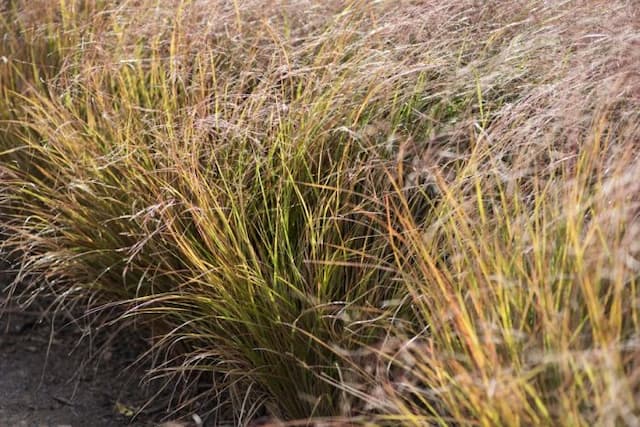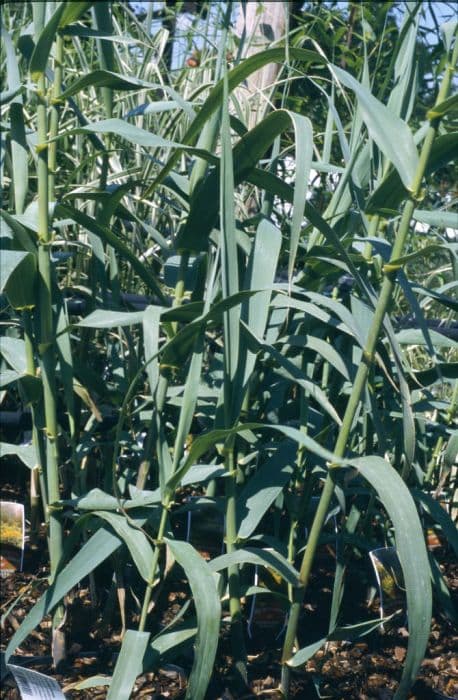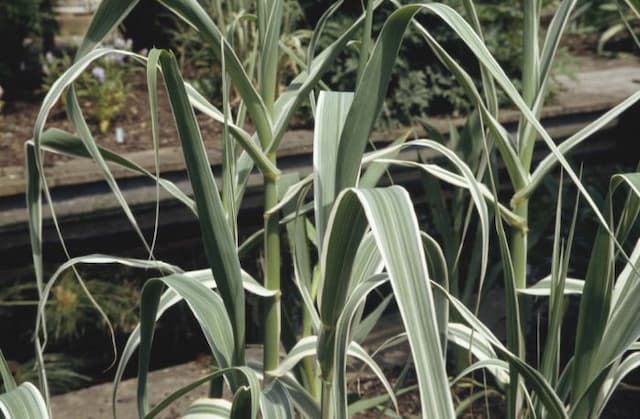Umbrella bamboo 'Luca' Fargesia murielae 'Luca' (PBR)

ABOUT
'Luca' is a dwarf, clump-formingbamboo reaching 50cm tall and slowly spreading to 1m or so. It has narrow, pointed, bright, evergreen leaves
About this plant
 Names
NamesFamily
Poaceae
Synonyms
Umbrella Bamboo, Muriel's Bamboo
Common names
Fargesia murielae 'Luca' (PBR)
 Characteristics
CharacteristicsLife cycle
Perennials
Foliage type
Evergreen
Color of leaves
Green
Height
10 feet (3 meters)
Spread
6 feet (1.8 meters)
Plant type
Shrub
Hardiness zones
7
Native area
China
Benefits
 General Benefits
General Benefits- Ornamental Value: Adds aesthetic appeal to gardens with its elegant, arching culms and lush green foliage.
- Privacy Screen: Can be used to create natural privacy barriers due to its dense growth habit.
- Low Maintenance: Requires minimal care once established, making it suitable for busy or novice gardeners.
- Cold Hardy: Tolerates cold temperatures well, making it suitable for a range of climates.
- Non-Invasive: Unlike some bamboo species, it has a clumping growth pattern, reducing the risk of unwanted spread.
- Shade Tolerant: Grows well in partially shaded areas, providing flexibility in garden design.
- Windbreak: Can act as a wind barrier when planted in rows, protecting sensitive areas of the garden.
- Soil Erosion Control: Its root system helps stabilize soil on slopes and prevent erosion.
- Acoustic Barrier: The dense growth can help reduce noise pollution when planted along roads or busy areas.
- Habitat for Wildlife: Provides shelter and food for birds and beneficial insects.
- Year-Round Interest: Evergreen in nature, it maintains its appearance throughout the seasons.
- Container Planting: Can be grown in pots or containers for patios or balconies where ground planting isn't feasible.
 Medical Properties
Medical PropertiesThis plant is not used for medical purposes.
 Air-purifying Qualities
Air-purifying QualitiesThis plant is not specifically known for air purifying qualities.
 Other Uses
Other Uses- Musical Instrument Craft: The canes of Fargesia murielae, commonly known as Umbrella Bamboo, can be used to create flutes and other wind instruments due to their hollow structure and natural resonance.
- Garden Stakes: Umbrella Bamboo canes are strong yet flexible, making them ideal for use as garden stakes or supports for climbing plants and vegetables.
- Decorative Screens: The dense growth habit of Umbrella Bamboo makes it suitable for creating natural, living decorative screens for privacy in gardens or on patios.
- Art Material: Artists can utilize the canes and leaves of the plant for crafting sculptures, mixed-media art pieces, or natural canvases for eco-friendly art.
- Fish Tank Decoration: When properly treated to prevent decay, small segments of Umbrella Bamboo can be used as decorative elements in aquariums, providing aesthetic appeal and hiding spots for fish.
- Sustainable Crafting: The plant's canes can be used to create eco-friendly crafts, such as baskets, mats, or even lightweight furniture, emphasizing sustainability.
- Culinary Garnishing: Though not a common practice, the leaves of the Umbrella Bamboo could be used as a unique, decorative garnish for culinary dishes in high-end restaurants seeking an exotic presentation.
- Sound Insulation: The dense growth of the Umbrella Bamboo can serve as a natural sound barrier when planted along property lines or busy streets.
- Erosion Control: Umbrella Bamboo's root system can help stabilize soil on slopes or riverbanks, preventing erosion and promoting soil health.
- Photography Prop: Professional and amateur photographers may use the aesthetic appeal of Umbrella Bamboo as a natural backdrop or prop for portrait and landscape photography.
Interesting Facts
 Feng Shui
Feng ShuiUmrella Bamboo is not used in Feng Shui practice.
 Zodiac Sign Compitability
Zodiac Sign CompitabilityUmbrella Bamboo is not used in astrology practice.
 Plant Symbolism
Plant Symbolism- Resilience: Fargesia murielae, commonly known as the Umbrella Bamboo, symbolizes resilience due to its ability to bend in the wind without breaking, much like the trait of being able to adapt to and recover from difficult conditions.
- Flexibility: The Umbrella Bamboo is also symbolic of flexibility because of its lithe stems that sway with ease, paralleling the idea of being flexible and adaptable in life's situations.
- Privacy: Given its dense growing habit, the Umbrella Bamboo often represents privacy and seclusion, as it can form a natural screen that shelters from the outside world.
- Growth: Representing growth and personal development, the fast-growing nature of the Umbrella Bamboo parallels the idea of continuous learning and self-improvement.
- Peace: Its lush, green foliage and the gentle rustling sound the leaves make in the breeze convey a sense of peace and tranquility.
 Water
WaterFor Umbrella Bamboo 'Luca', regular watering is essential, especially during its first growing season to establish a deep and extensive root system. Water the plant deeply when the top inch of soil feels dry, which typically equates to about every 7 to 10 days, depending on weather conditions. During hotter, dryer periods, the frequency may increase. Use a soaker hose or drip irrigation to provide a slow, thorough soaking of the root zone. As a rough guide, provide about 1 to 1.5 gallons of water per week during regular weather, adjusting as necessary for temperature fluctuations and rainfall.
 Light
LightUmbrella Bamboo 'Luca' prefers a spot that offers partial shade to full sun. It thrives in an area that receives several hours of morning sunlight with afternoon shade, or dappled light throughout the day. Avoid placing it in deep shade or exposing it to the harsh afternoon sun, which can scorch the leaves.
 Temperature
TemperatureUmbrella Bamboo 'Luca' can tolerate a range of temperature conditions, ideally growing best between 65°F and 75°F. It is hardy and can survive minimum temperatures down to about 5°F and can withstand up to about 95°F, although prolonged heat can stress the plant.
 Pruning
PruningPruning Umbrella Bamboo 'Luca' is typically done to remove any dead or damaged culms and to maintain its shape or size. Prune in the late winter or early spring before new growth begins. It's usually sufficient to prune every 1 to 2 years unless shaping is desired for aesthetic reasons or to remove sporadic damaged shoots.
 Cleaning
CleaningAs needed
 Soil
SoilUmbrage Bamboo or Umbrella Bamboo requires a soil mix that is rich, well-draining, and slightly acidic to neutral in pH, ideally ranging from 5.5 to 7.0. A mix of loamy soil with added organic matter such as compost or well-rotted manure will help to provide the necessary nutrients and structure for the roots.
 Repotting
RepottingUmbrella Bamboo should be repotted every two to three years to ensure it has sufficient room to grow and to refresh the soil. Younger plants may grow more quickly and require more frequent repotting.
 Humidity & Misting
Humidity & MistingUmbrella Bamboo thrives in moderate to high humidity levels. Aim for a humidity range of around 40-60% if possible, as this will help mimic its natural environment.
 Suitable locations
Suitable locationsIndoor
Place in bright, indirect light; ensure high humidity.
Outdoor
Plant in partial shade, protect from intense afternoon sun.
Hardiness zone
5-9 USDA
 Life cycle
Life cycleFargesia murielae 'Luca', commonly known as Umbrella Bamboo, begins life as a seed, which upon germination, grows into a seedling with rudimentary leaves. The seedling develops into a young plant, establishing a rhizome system that spreads underground. As it matures, the clumping bamboo produces sturdy culms (stems) that reach their height quickly, usually within a few months, and then fill out with leafy branches. In its adult stage, Umbrella Bamboo maintains its dense foliage and can produce new culms annually given optimal conditions. Unlike many bamboos, Fargesia varieties do not have a synchronized flowering cycle, but when they do flower, it could potentially lead to the death of the particular clump that has flowered. After flowering, seeds are produced, potentially starting a new generation if conditions allow for germination.
 Propogation
PropogationPropogation time
Spring-Early Summer
Propogation: Fargesia murielae 'Luca', commonly known as Umbrella Bamboo, is most effectively propagated through division, usually in the spring when the plant's growth is most vigorous. To propagate by division, carefully dig up the clump of bamboo and use a sharp spade or a saw to separate the rhizomes, ensuring that each division has at least one culm (canestalk) and a portion of the root system attached. These divisions can then be replanted in well-draining soil at the same depth they were previously growing. It is essential to keep the newly transplanted divisions well-watered, especially during their first growing season, to establish a strong root system. Propagation through division helps maintain the clonal fidelity of 'Luca', preserving its unique characteristics.









